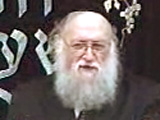Beit Midrash
- Sections
- Chemdat Yamim
- Bemare Habazak - Rabbis Questions
- Library-Sifria
- Likutim A
- Hashem's Name and Holy Writings
Answer: One must treat a sefer Torah with great respect (Shulchan Aruch, Yoreh Deah 282:1), but the halachot mentioned there do not talk about grounds for taking it out of the aron.
The main halacha about moving a sefer Torah is in the Shulchan Aruch, Orach Chayim 135:14, based on the Yerushalmi (Yoma 7:1). It is forbidden to bring a sefer Torah to a new location even to be used for its purpose – kri’at haTorah. It is a bizayon (disgrace) to bring the sefer Torah to people; people should come to it (ibid.)!

Bemare Habazak - Rabbis Questions (627)
Rabbi Daniel Mann
415 - Simchat Torah for those Not Completing the Torah Reading
416 - Taking Out a Sefer Torah for a Child to See
417 - Davening for a Friend on Shabbat
Load More
We presented the above list, which do not apply to your question, in order to share our general dilemma. Is the concept of bizayon the basis for Chazal forbidding specifically moving a sefer Torah from place to place even for good purposes, but taking from the aron to the bima is permitted even for a neutral purpose? If so, why not show a sefer Torah to a sweet kid who will someday learn Torah?! Or is there generally a high bar of respect for the sefer Torah, which precludes even positive actions, if they are not in line with what the Torah is supposed to be used for? If so, with all due respect and affection for two-year olds, their love for a sefer Torah is like that for a shiny new toy (confirmed after consultation with early childhood experts) and in light of the high bar, it is a bizayon to take it out.
I have seen few and unimpressive sources on this matter. One forbade taking a sefer Torah out to practice laining (see Hamaor, vol. 83); Piskei Teshuvot 135:5 understood that some prohibit doing an unnecessary laining). While all permit taking out sifrei Torah for dancing on Simchat Torah (at least as long as they stay inside – see discussion on taking outside or moving from shul to shul in Yabia Omer VII:56 and elsewhere) but some say that the minhag to lain at night is to strengthen the justification for taking them out. It is hard to determine which approach is accepted, but the simple reading of the Shulchan Aruch (YD 282:1) is that there is a broad high bar in addition to specific applications that classical sources discussed.
One can argue that there is value in showing off the sefer Torah to people. The gemara (Yoma 70a) relates how individuals would bring their sifrei Torah on Yom Kippur to the Beit Hamikdash to show its beauty. One of the explanations why this was permitted is that doing so honored the sefer Torah. Some apply this idea broadly (Gur Aryeh Yehuda, YD 24), while others limit it to special cases like the Beit Hamikdash (see Beit Avi IV:126, opposing a glass-case display of a sefer Torah in a Jewish museum). While we would be supportive of taking out a sefer Torah to show a group of unaffiliated Jews to try to impress/inspire them, it is difficult to justify for a small child who has and will iy"H see it throughout his life. There are many other ways to build excitement about Torah, and a toddler can be told and rewarded for accepting (on his level) that the sefer Torah is so kadosh that we take it out only for kri’at haTorah.

Ask the Rabbi: Indirect Responsibility for Theft
Rabbi Daniel Mann | Shevat 5785

Ask the Rabbi: What May One Do before Havdala after Yom Kippur?
Rabbi Daniel Mann | Tishrei 5786

Ask the Rabbi: Using Replacement Mezuzot When They Are Being Checked?
Rabbi Daniel Mann | Av 5785

Ask the Rabbi: Wearing a Kippa in Today’s US Social Atmosphere
Rabbi Daniel Mann | Tammuz 5785

Rabbi Daniel Mann

Ribbit in a Loan from an Irrevocable Trust Fund
Adar 7 5777

Pay for Overtime on Shabbat
5773

Cooking for Shabbat at the End of Yom Tov
Iyar 20 5783
























